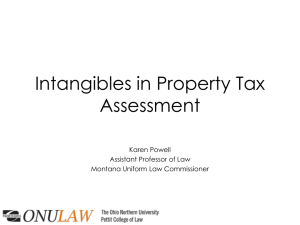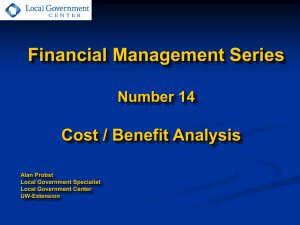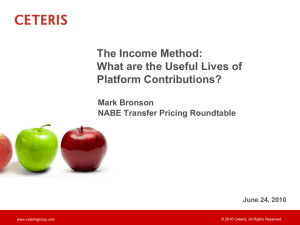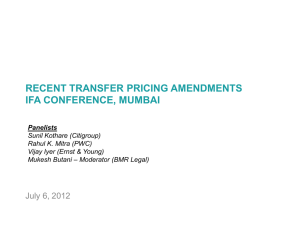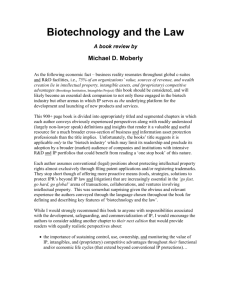OECD Revised Discussion Draft on Intangibles
advertisement
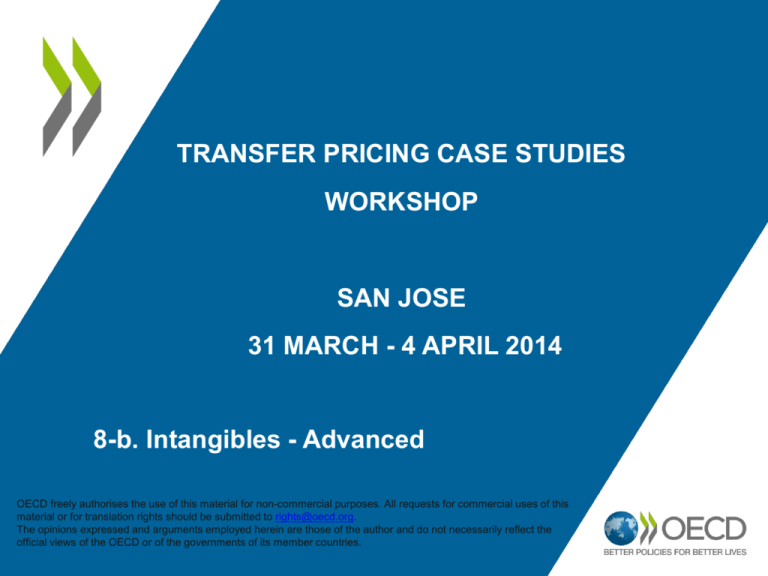
TRANSFER PRICING CASE STUDIES WORKSHOP SAN JOSE 31 MARCH - 4 APRIL 2014 8-b. Intangibles - Advanced OECD freely authorises the use of this material for non-commercial purposes. All requests for commercial uses of this material or for translation rights should be submitted to rights@oecd.org. The opinions expressed and arguments employed herein are those of the author and do not necessarily reflect the official views of the OECD or of the governments of its member countries. Transfer Pricing Aspects of Intangibles • Initial Discussion Draft published June 2012 • Public consultation November 2012 • Revised Discussion Draft (RDD) published July 2013 • Public consultation November 2013 in Paris • Targeted completion by September 2014 as part of work on BEPS 3 Basic Definition of an Intangible “The word intangible is intended to address something which is not a physical asset or a financial asset, which is capable of being owned or controlled for use in commercial activities, and whose use or transfer would be compensated had it occurred in a transaction between independent parties in comparable circumstances.” RDD para. 40 4 Elements Required to be an Intangible • Capable of being owned or controlled – Does not include local market conditions (eg good weather; structure of market) – Does not include MNE group synergies which are not owned or controlled by a single member of an MNE group • Capable of being used in commercial activities • Use or transfer would be compensated in transactions between independent parties • Not a physical asset or a financial asset 5 Elements Not Required • Need not be an intangible for accounting purposes • Need not be an intangible for general tax or treaty withholding tax purposes – Article 12 MTC • Need not be legally protected • Need not be separately transferable 6 Illustrations (1) • The following are intangibles: – Patents – Know-how and trade secrets – Trademarks, trade names and brands – Contract rights including government licences and contractual commitments to make a workforce available – Licences and other limited rights in intangibles – Goodwill and ongoing concern value 7 Illustrations (2) • The following are not intangibles: – Group synergies – Market specific characteristics – Location savings – Workforce, but see prior slide on contract rights and obligations 8 What Difference Does the Definition Make? • Intangibles need to be paid for if they are transferred, either separately or together with other assets • Intangibles also can affect the arm’s length price of other transactions • Comparability factors do not need to be separately paid for since they cannot be owned, controlled or transferred, but they may affect the arm’s length price for other transactions • An important point: The fact that an item is not an intangible does not mean it can be ignored in a transfer pricing analysis or that a taxpayer can claim to transfer that item without compensation 9 TRANSFER PRICING TREATMENT OF IMPORTANT COMPARABILITY FACTORS 10 Intangibles and Comparability Factors • Chapter I of the TPG is expanded to discuss important comparability factors: – Location savings – Other local market features – Assembled workforce – MNE group synergies 11 Location Savings • Cost savings attributable to conducting business operations in a particular geographic market • RDD relies on guidance already in Chapter IX – TPG ¶9.148 – 9.153. States that the Chapter IX guidance is generally applicable – there is no new approach to location savings • The key point is that when there are good local market comparables they provide the best evidence of how benefits of location savings are to be allocated between associated enterprises 12 Location Savings (2) • Where there are no local market comparables then all relevant facts and circumstances should be considered to determine: – Whether location savings exist – The amount of any location savings – Whether they are passed on to independent customers or suppliers – How any net location savings not passed on to customers and suppliers should be allocated 13 Local Market Features • Features of the local market can affect comparability and adjustments are sometimes necessary • Examples: Size of market, growth in market, proximity to customers, purchasing habits of households, infrastructure, educated labour pool, etc • As with location savings, where local market comparables are available they provide the best measure of how benefits arising from features of local market should be allocated. Otherwise a facts and circumstances analysis • No presumption that benefits of local market features all belong to local market entity 14 Assembled Workforce • Value of assembled workforce can affect the price for services provided by that workforce – comparability adjustments may be required • Ordinarily no charge for transfer or secondment of individual employees beyond payment for employees’ services • However, in some cases transfers and secondments of individual employees can also lead to a transfer of know-how, which should be analysed under Chapter VI 15 MNE Group Synergies • RDD recognises that comparability adjustments may need to be made for MNE group synergies in some cases • First question is whether the group synergy arises purely as a result of group membership, in which case it does not need to be paid for, or whether it arises from concerted group action • If the latter, the benefit of the synergy should be shared by group members on the basis of their contributions to the creation of the synergy • Example: Centralised purchasing and volume discounts. 16 OWNERSHIP OF INTANGIBLES AND RIGHTS TO RETURNS ATTRIBUTABLE TO INTANGIBLES 17 Ownership of Intangibles: framework for analysis 1. Identify the legal owner 2. Identify parties performing functions, using assets and assuming risks related to the development, enhancement, maintenance & protection of intangibles 3. Confirm consistency between agreements and conduct (TPG ¶ 1.53) 4. Identify relevant controlled transactions 5. Where possible determine an arm’s length price for relevant transactions identified 6. In exceptional cases (per TPG ¶1.64 – 1.68), recharacterise transactions as necessary to reflect arm’s length conditions 18 Legal Ownership and Important Functions • Legal ownership is the starting point of the analysis, but – – Legal ownership alone does not convey a right to ultimately retain any income attributable to intangibles – The legal owner must compensate associated enterprises for their contributions (FAR) 19 Important functions • At arm’s length, the legal owner would generally perform important functions itself, including: – Design and control of research and development – Management and control over budgets – Control over strategic decisions related to intangible development – Decisions regarding defence and protection of intangibles – On-going quality control • If outsourced to associated enterprises, the party performing such important functions should not generally be treated as the tested party in applying one sided methods for pricing transactions related to intangible development 20 Role of Funding • Funding is important and should be evaluated in determining arm’s length prices • An entity merely providing funding but not performing functions or assuming risks should receive a lower return than entities that perform functions and assume risks • Risk adjusted return on capital invested but not more, consistent with similar unrelated party arrangements 21 Role of Risk Assumption • Risk can be important and should be compensated • Needs to be evaluated separately from funding. Paying money does not necessarily correlate precisely with assuming risk • Guidance on risk in Chapter IX should be applied – Control – Financial capacity 22 IDENTIFYING AND CHARACTERISING RELEVANT TRANSACTIONS 23 Two Classes of Transactions • Transfers of intangibles or rights in intangibles – Includes sales of intangibles and other transactions that have the same economic effect – Also includes licenses of intangibles and other transactions involving transfers of partial interests in intangibles. • Transactions where intangibles are used but not transferred 24 Considerations in Characterising Transfers of Intangibles • Identifying the terms of transactions involving intangible transfers • Characterising actual transactions by reference to conduct of the parties • Specifically identifying all transferred intangibles, including combinations of intangibles • Identifying any relevant restrictions or limitations on the rights transferred • Identifying transactions where intangibles are transferred in combination with other transactions undertaken (e.g. sale of goods or performance of services). 25 IDENTIFYING ARM’S LENGTH PRICES FOR TRANSACTIONS INVOLVING INTANGIBLES 26 General Principles • The general rules of Chapters I – III of the TPG apply to transactions involving both transfer and use of intangibles • Realistic alternatives for each of the parties need to be considered in transactions involving both transfer and use of intangibles • The perspectives of both parties to the transaction need to be taken into account 27 Comparability Issues • In applying the principles of Chapters I – III, comparability of the intangibles being examined is a critical concern • Because intangibles often have unique features, the comparability analysis is especially important in matters involving intangibles • Often it will not be possible to identify sufficiently comparable intangibles to support an analysis based on comparables 28 Important Comparability Factors for Intangibles • • • • • • • Exclusivity Geographic scope Useful life Stage of development Rights to enhancements, revisions and updates Expectation of future benefits Other factors may be important in specific cases 29 Comparisons of Intangible Related Risk • Important risks to be considered – Risks related to future development of intangibles – Risks related to product obsolescence and intangible devaluation – Risks related to infringement of intangible rights – Product liability and similar risks – Other risks in specific cases 30 Other Comparability Concerns • Reliability of any proposed adjustments to comparable intangibles • Use of comparables drawn from databases – Not prohibited to use information from databases – But need to consider whether enough information exists to evaluate the comparability factors set out above – Other provisions of the TPG on use of databases are fully applicable 31 Selecting the Most Appropriate Method • General principles of TPG ¶ 2.1 – 2.11 apply – Aggregation of transactions – Use of more than one method • Any of the OECD approved methods can be used in appropriate circumstances 32 Transfer Pricing Methods • Any of the five OECD transfer pricing methods may apply in matters involving transfers of intangibles. • Valuation techniques are useful tools • Cautions regarding the use of some methods – Cost based methods discouraged except for limited application to matters involving internal use intangibles – One sided methods (TNMM and RPM) not typically useful to directly value intangibles, but may be used in some residual valuation approaches 33 Most Useful Methods • CUP – where comparable transactions involving comparable intangibles can be identified • Profit split – but further work on profit split methods called for under the BEPS Action Plan • Valuation techniques 34 Use of Valuation Techniques • Use of valuation techniques specifically approved • No comprehensive summary of acceptable valuation techniques • No endorsement of particular valuation practices or standards • Purchase price valuations are not determinative for transfer pricing purposes • Techniques based on discounted value of cash flows can be especially useful – But with an important caveat: Assumptions underlying application of valuation techniques must be carefully considered. Such techniques must be applied using assumptions that are consistent with the arm’s length principle 35 Assumptions to Be Considered • Small changes in assumptions can create large changes in valuation outcome. Therefore important to consider: – Accuracy of financial projections – Assumptions regarding growth rates – Estimates of discount rates – Useful life and terminal values – Assumptions regarding taxes 36 Hard to Value Intangibles • Additional work on hard to value intangibles is deferred and will be considered under the BEPS Action Plan – Partially developed intangibles with no financial track record – Intangibles that are extremely critical to the business and have no real comparables 37 Form of Payment • Taxpayer structure of payment terms should generally be respected (i.e. lump sum payment, payments contingent on use or profit, periodic royalties) • But the risks associated with different payment terms should explicitly be taken into account in determining arm’s length compensation 38 Transactions Involving Use But Not Transfer of Intangibles • General rules of Chapters I – III apply • Intangibles are an important comparability factor • Comparables can often be found even where intangibles are used by one or both parties • Where the existence of unique and valuable intangibles makes comparability difficult, methods not relying on comparables, including profit splits and valuation techniques may be necessary 39 Questions and/or comments?

